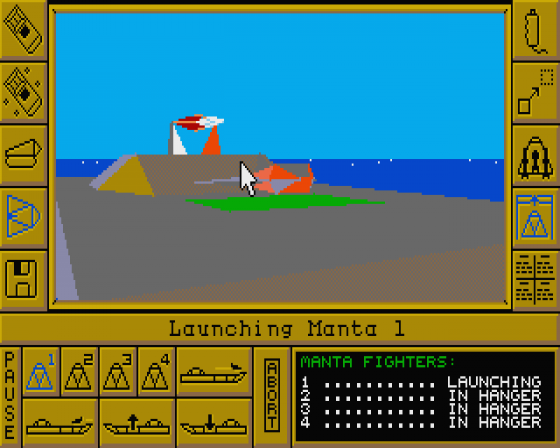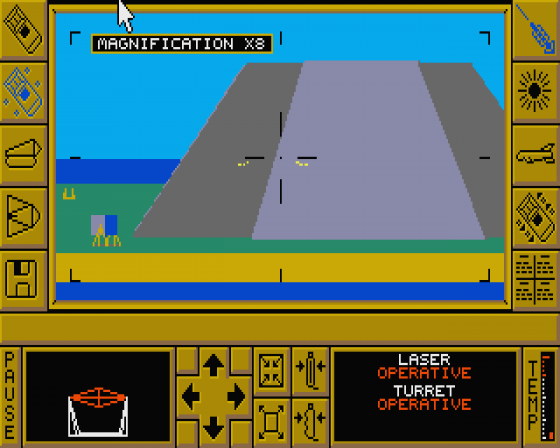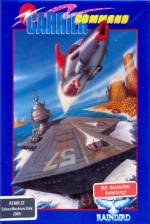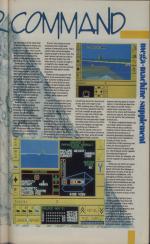
C&VG
 1st January 1988
1st January 1988
Categories: Preview: Software
Published in Computer & Video Games #75
Carrier Command
This is advanced war, 21st Century style. The danger to human life is kept to a minimum as remote-controlled, planes, ships, and tanks battle for victory. This is the world of Carrier Command from Rainbird. David Bishop kept a safe distance from the war zone and filed this report.
The time in the 21st Century. The place is an archipelago of 64 islands somewhere in the Pacific ocean. The mission is to overthrow the enemy forces that are, even as you read this, mounting numerous attacks on the few islands you still control.
Because of the danger to human life, warfare in the 21st Century has become a very much more refined and remote affair. One consequence is that almost all naval, aerial, and land based engagements now involve remote-controlled planes and tanks. Long gone are the days when there were real people inside. That would be far too dangerous. Wars there still are, but at least they're safe wars!

This is the world of Carrier Command. A spectacular new game created by Realtime Software (or Starstrike I and II and Starfox fame), based on an idea by Clare "Arcade Action" Edgeley. Carrier Command is a mixture of arcade and strategy, neatly blended into a fast moving game of quick reflexes, both mental and physical.
Although the original concept was not their own, it was left to Realtime to take the initial outline and develop a fully fledged game from a collection of ideas.
Realtime's Ian Oliver recalls: "Firebird faxed the original spec to us at the end of February. At that time, the game existed on two and a half sides of A4. Since then, the design has developed in parallel with the programming. We've already got 27,000 lines of code which makes it one of, if not the largest 68000 game program to date."

At the start of the game, both sides have the same forces consisting of four jet fighters, amphibious tanks, and drones, and an aircraft carrier (ACC) fitted with the latest in laser turret technology.
All this deadly hardware tends to get into a myriad of tricky situations such as being blown out of the sky, or sunk without trace. Luckily you're sitting smug, well fairly smug anyway, in your central control room secreted deep in the heart of your ACC. Here you are immune from attack, unless of course your ACC is sunk, well I only said fairly smug!
Your ACC is most vulnerable to attack by surface to surface missiles, launched either by the enemy's tanks, or by island based missile installations. Luckily, you start the game with four drones, whose only reason for existence, is to get destroyed by missiles that would otherwise have hit the ACC. To this end, you can manipulate your drones so that they are between you and the most likely direction from which an attack will occur. There are a number of preset drone configurations you can call up, or you can place each one individually around the ACC.

Each piece of your arsenal is fitted with an on-board camera, so you can call up a plane, for example, and fly it as if you were actually sitting in the cockpit. Once that plane is on course or in a holding manoeuvre, you can leave it and can call up another plane or tank elsewhere on the map.
Both planes and tanks start their life inside the ACC. Tanks exist out of the ACC's stern, while planes taxi from the ACC hanger onto the internal lift which brings them up onto deck, ready for take-off. The view inside the hangar will show any unlaunched (or newly built) planes waiting patiently to be taken into battle.
Due to the communications satellites in use, the effective remote control range of planes and tanks is a mere 15 kilometres radius from your ACC. Fly out of range and you'll start hearing static. Unless you turn back, you risk losing a plane forever, which is severely uncool.

Although you can send each of your four planes off in different directions, there will be times when you want them all to go to the same place at the same time. By entering formation mode, you can 'slave' one or more of your planes to a master, which you fly. Until released, the slave planes will emulate every move that the master plane makes, unless they get shot down, or run out of fuel.
Both planes, tanks, and the ACC can be armed with various different weapons for long and short range warfare. Tanks are fitted with a front mounted high power/low range chemical laser that needs recharging every 40 shots. Tanks can also be equipped with short range wire-guided missiles. They are also your only means of transporting both virus bombs, or which more later, and auto-control centre buildings, used to replace a destroyed control centre on an island.
Because your ACC is so vital to the cause, as well as being incredibly expensive, it is well protected with dual anti-missile systems. First there's ECM (Electronic Counter Measure), which sends up a cloud of metallic particles designed to confuse the radar guidance systems of any incoming missile. Secondly, the ACC is equipped with anti-missile missiles that are automatically launched at any approaching danger.

The ACC also boasts a turret mounted, short range laser cannon of awesome power. This is used to take out aerial targets, stupid enough to fly too close. The laser cannon can also be used to pick off shore targets, but only when the ACC is close enough to an island to be a target itself, unless of course, you have already destroyed that island's missile launchers.
Planes can be equipped with either a low power/short range laser (used for strafing ground targets), or the facility to drop bombs on island targets, albeit with a limited payload capacity. Planes can also be fitted with medium range heat-seeking missiles, useful against other aircraft.
In addition a plane can carry a long range communication pod, which will allow it to fly before the normal range of 15 kilometres from the ACC, thus giving it more autonomy to engage the enemy further afield.

And when you look at the magnitude of the map, it's no wonder a long range pod had to be developed. The 64 islands are spread over a vast square 8x8 grid. Each of the 64 smaller squares in the grid is the equivalent to 200 kilometres across. The entire map would take about two hours to fly across, and a lot longer to sail.
With a playing area of this size, it soon becomes apparent that this isn't just a straight arcade game where you zap over a titchy map shooting at things willy nilly - although this one approach! Death and destruction there is, but this is more your designer carnage than something out of Rambo VII.
Of the 64 islands, some are in the hands of the enemy (shown as red on the map), some are under your control (blue), but the majority start the game as neutral (green). Controlling an island has two distinct benefits. Firstly, it means there's one less in the hands of the enemy and therefore one less to capture, and secondly it can be used for the production of resources.
On green, unaligned islands, you can install a defence program, which will set about creating a Building Control Centre which co-ordinates the production of resource generating installations on the island. Such installations include oil wells, for the production of fuel resources, and mines, for the production of mineral resources for spare parts etc. Not all islands will be capable of producing all types of resources. Some, for example, will only be capable of supporting oil mines.
Unless you are either very quick or very lucky, taking an enemy island will involve the damage or destruction of some, if not all, of that island's installations. Until damaged or hitherto unbuilt (in the case of newly taken neutral islands) island installations are fully functional, no resources will be generated by the island, although it is now considered as 'one of yours' and is shown as blue on the map.
At the time of going to press Carrier Command was about 65 per cent complete. There is little doubt that it will set a new standard in 3D filled graphics, and help to establish Realtime Software as one of the leading exponents of this genre of game. The game is coming out first for the Atari ST (price £24.95), happily in colour and mono - don't miss it!
This article was converted to a web page from the following pages of Computer & Video Games #75.





